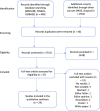Evidence-based review of the effects of nutritional supplementation for pressure ulcer prevention
- PMID: 34528752
- PMCID: PMC8613380
- DOI: 10.1111/iwj.13584
Evidence-based review of the effects of nutritional supplementation for pressure ulcer prevention
Abstract
The objective of this evidence-based review was to explore whether the evidence supports the use of nutritional supplements in pressure ulcer (PU) prevention strategies. Several electronic databases, including Ovid MEDLINE (1946 to May week 32 019), Ovid EMBASE (1947 to May 28, 2019), EBSCO CINAHL (until June 13, 2019), Scopus (until July 9, 2019), and the Web of Science (until June 13, 2019) were searched. No limitation was placed on the year of publication. Studies considered for inclusion were those with adult populations, and only English language texts with available full text were reviewed. AMSTAR (a measurement tool to assess systematic reviews) was used to evaluate the quality of the studies included in the systematic review. The Oxford Centre for Evidence-Based Medicine (OCEBM) 2011 Levels of Evidence was used to assess the level of evidence. Appraisal of Guidelines for Research and Evaluation Instrument (AGREE II) was used to assess guideline article, and Appraisal tool for Cross-Sectional Studies (AXIS) was also used for cross-sectional studies. The search identified 1761 studies. After the application of inclusion and exclusion criteria, 24 studies were retained of various designs, including 10 systematic reviews, five clinical reviews, three randomised controlled trials, two observational studies, one quasi-experimental study, one cross-sectional study, one cohort study, and one Clinical Guideline. Two were rated as high-quality reviews, 14 were rated as moderate-quality reviews, five were rated as low-quality reviews, and three were rated as critically low-quality reviews. The majority of the reviewed studies were of low-to-moderate quality because of biases in the study design and incomplete data reporting, which did not fulfil the reporting criteria of the appraisal tools. However, the majority of the studies showed a reduction in PU incidence after nutritional supplement though not significant. Whether the use of pharmacological appraisal tools to assess non-pharmacological studies is appropriate is unclear. Regardless of the low-to-moderate quality of the studies in this review, nutritional supplements appear to play a role in PU prevention.
Keywords: evidence-based review; nutrition supplement; pressure injury; pressure ulcer; prevention.
© 2021 The Authors. International Wound Journal published by Medicalhelplines.com Inc (3M) and John Wiley & Sons Ltd.
References
-
- Berlowitz DR, Brienza DM. Are all pressure ulcers the result of DTI: a review of the literature. Ostomy Wound Manag. 2007;53(10):34‐38. - PubMed
-
- Mallar Z, Nassar N, Badr LK. The effectiveness of a pressure ulcer intervention program on the prevalence of hospital acquired pressure ulcers: controlled before and after study. Appl Nurs Res. 2015;28(2):106‐113. - PubMed
-
- Soeters P, Bozzetti F, Cynober L, Forbes A, Shenkin A, Sobotka L. Defining malnutrition: a plea to rethink. Clin Nutr. 2017;36(3):896‐901. - PubMed
-
- Poulia KA, Klek S, Doundoulakis I, et al. The two most popular malnutrition screening tolls in the light of the new ESPEN consensus definition of the diagnostic criteria for malnutrition. Clin Nutr. 2017;36(4):1130‐1135. - PubMed
Publication types
MeSH terms
LinkOut - more resources
Full Text Sources
Medical


